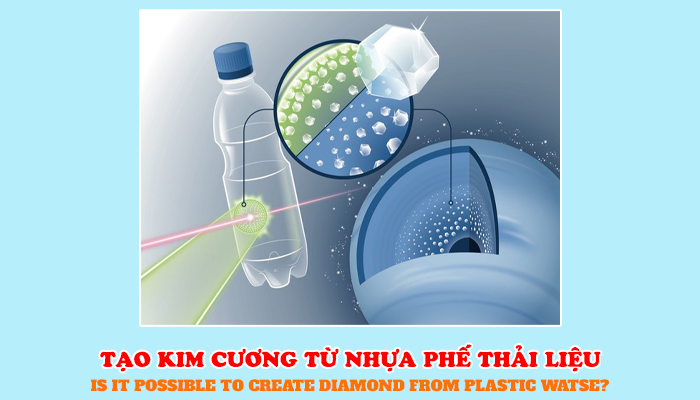
IS IT POSSIBLE TO CREATE DIAMONDS FROM PLASTIC WASTE?
Science has proven that under extreme pressure and extremely high temperatures below the surface of the planets, hydrocarbons are formed into diamonds, a crystal everyone wants to own.
GRAPHENE: THE SUPER MATERIAL FORMULATED FROM PLASTIC
COOLING PAINT
PLASTIC FOAM RECYCLING
FLEXIBLE GLASSES - INSPIRATION FROM SEASHELLS
IS IT POSSIBLE TO CREATE DIAMONDS FROM PLASTIC WASTE?
Science has proven that under extreme pressure and extremely high temperatures below the surface of the planets, hydrocarbons are formed into diamonds, a crystal everyone wants to own.
But on Neptune and Uranus billions of kilometers from Earth, the universe's diamond-making process is a little different from what we know. Since the 1970s, scientists believe that the two planets have literally rained diamonds.
In 2017, researchers in Germany and California (USA) found a way to recreate ideal conditions on Neptune and Uranus.
They made tiny diamonds called nanodiamonds in the lab using polystyrene (aka Styrofoam). Five years later they tried again, this time using quality polyethylene terephthalate (PET).
Research published last weekend in the journal Science Advances is expected to open a new direction in creating recycled nanodiamonds from plastic waste.
The question here is why there are so many different plastic materials in the world, that scientists choose to create diamonds from food containers or water bottles.
Dominik Kraus, a scientist at the German research laboratory Helmholtz-Zentrum Dresden-Rossendorf and the lead author of the study, replied via email that there is a good reason for this.

Kraus and his colleagues fabricated nanodiamonds out of polystyrene (compounds containing the elements carbon and hydrogen-like those found on Neptune and Uranus). They bombarded the material using a Linac coherent light source - a high-powered laser at the SLAC National Accelerator Laboratory in California (USA).
This process rapidly heats polystyrene to 5,000 degrees K (more than 1,000 degrees Celsius) and compresses it to 150 gigapascals, simulating the natural conditions in the cores of icy planets.
While the researchers created the microscopic light from the lasers, they realized that an important chemical component was missing: oxygen. So they turned to PET, which is not only more common than polystyrene but also has a good balance of carbon, hydrogen and oxygen.
"The chemistry, in this case, is very complex and it is challenging to simulate natural conditions. Anything can happen is a typical phrase when discussing with theoretical researchers - explains Mr. Kraus - There have been some predictions that the presence of oxygen helps carbon separate from hydrogen and form diamonds, but there are also opinions to the contrary."
Research is not limited to creating sparkling diamonds from waste plastic. The researchers are looking to better understand the extreme environmental conditions on the planets to understand how literally diamond showers are produced.
>> Click HERE for the best paint chemicals on the market<<
Contact
MEGA VIETNAM
Office address: Floor 2-A2-IA20, Nam Thang Long Urban Area, Pham Van Dong Street,
Dong Ngac Ward, Bac Tu Liem District, Hanoi City, Vietnam
Email: contact@megavietnam.vn
Tel: (+84) 24 375 89089; Fax: (+84) 24 375 89 098
Website: megavietnam.vn
Hotline: 1800.577.728 Zalo: 0971.023.523





